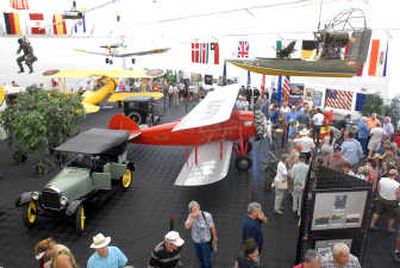Camp Invention planned at Bird Museum

Don’t let the lingering snow fool you – it’s the end of March, and in less than two months schools will release their restless quarry for summer break. Parents who hope to keep their children actively engaged during the vacation will want to include a visit to Sandpoint’s Bird Aviation Museum and Invention Center.
A desire to stimulate the imagination of America’s children and introduce them to worthwhile role models is the driving force behind the 16,000-square-foot museum that will celebrate its first anniversary this July. Admission is by donation only. “It’s not commercial,” explains Dr. Forrest Bird. “It’s educational. It’s for the kids. They’re the future.”
Young visitors are treated to a scavenger hunt that offers an engaging challenge as they view everything from historic airplanes to automobiles, and learn about the invention of the Barbie doll, microphone, digital thermometer, and dozens of other products that have changed our world. An upper floor showcases prototypes of Bird’s invention of the respirator/ventilator, a device that has saved countless lives since 1947. Together, Bird, and his wife, Pam – who holds a doctorate in business administration and helps inventors get their products to market – make a perfect pair to run the museum.
In line with their desire to excite children’s creativity and interest in math and science, the Birds are proud to host Sandpoint’s first Camp Invention, a five-day program in partnership with the National Inventors Hall of Fame and the United States Patent and Trademark Office. The program will run July 7 through 11, and is open to students entering first through sixth grades.
“Bird Museum is recruiting certified teachers by word of mouth and recommendation,” says Rachel Riddle, the museum’s director of community relations and education. “(So far) we have teachers from Sandpoint Charter School, Farmin-Stidwell and Sagle Elementary.” Also on hand will be “real” innovators who have made a difference with their products and technologies. “Inventors come in all shapes and sizes,” says Pam Bird. “They’re people who see a problem and find a solution. Camp Invention teaches and accelerates creative thinking skills.”
Although daily activities are widely diverse and depend upon the exact curriculum being taught, kids can expect plenty of hands-on activities, brainstorming and experimentation. They may start their day immersed in science fiction after “crash landing” on Planet Zak. It will demand all their ingenuity and critical-thinking skills to design shelter, clothing and to find food. How will the weather affect their ability to survive? Will they be able to reassemble their damaged spacecraft using only common objects in time to blast off back to Earth?
Assuming they return alive from Planet Zak, kids may then be recruited to improve the design and safety features of a skateboard. They’ll create crash test dummies from recycled materials to test their new enhancements. Once they succeed, their skills will be put to the test as they work in teams to build and crash test cars using physics. Will they be able to design a three-point safety belt that’s capable of protecting an egg from being scrambled in an accident? Only time will tell.
On a different day, kids may become interns at the world’s newest and largest amusement park, Imagination Point. They’ll learn about inertia, centripetal force and Sir Isaac Newton’s three laws of motion while creating prototype miniatures of roller coasters and other amusement rides. Or they may create bumper-car paintings to illustrate that for every action, there is an equal and opposite reaction.
And while it may seem that many of these camp activities are geared to older children, the younger ones will be fully involved as well. In the “I Can Invent” module, both younger and older kids take apart broken household appliances. The younger ones build fantasy inventions using parts of these items along with others from the recycle room, while older kids design complicated machines that will launch a water balloon at a target. All the kids get to display their inventions at the Inventor’s Showcase.
All these tough mental challenges are interspersed with a lunch break, snacks and the physical activity of Recess Remix. This is a module that invites kids to participate in fun, energetic games that require teamwork, cooperation, coordination, and yes, you guessed it, more inventive thinking.
Whether you enroll your child in Camp Invention or just spend a leisurely morning at the museum, the experience is bound to encourage an interest in math and science, which, according to the Birds, is the whole point of the museum. As Forrest Bird says, “Today’s learning experiences translate into tomorrow’s technology.”